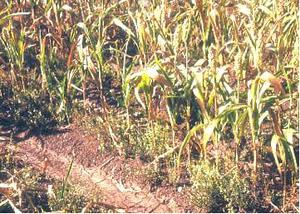BioterrorismAlien species: a dangerous new bioterrorism threat
Federal counterterrorism officials have a potentially catastrophic new threat to worry about – invasive alien species; the threat is so serious, Lawrence Roberge, an associate professor of anatomy and physiology at Laboure College, warned that terrorists could seek to use invasive species as biological weapons

Unlike most weeds, striga attacks the host roots, robbing it of nutrients // Source: .icrisat.org
Federal counterterrorism officials have a potentially catastrophic new threat to worry about – invasive alien species.
According to the Department of Agriculture, an invasive species is anything non-native to an ecosystem that can cause serious environmental, health, or economic harm as it is incompatible with a specific ecosystem. Native plants and animals are often defenseless against these invaders and tend to suffer from large declines in population as a result.
The threat is so serious, Lawrence Roberge, an associate professor of anatomy and physiology at Laboure College, warned that terrorists could use invasive species as biological weapons.
“In the hands of a rogue nation, terrorists, or an individual bent on destruction, an invasive species could have an affect similar to better known potential biological weapons such as smallpox or anthrax,” Roberge said.
Invasive species like weeds have been known to displace or destroy vegetation in natural habitats, while some have spread deadly diseases that ravaged animal populations like bats and frogs.
Roberge recently completed a study that explored the threats of invasive species consumed or carried by animals, insects, and plants and found terrorists could use them to selectively destroy parts of society and cause chaos, food shortages, and other forms of mass destruction.
For instance, the striga plant parasite is capable of laying waste to corn crops thereby devastating commodity markets and biofuel production. Meanwhile barberry plants eaten by birds could spread wheat stem rust, which could result in a drastic decline in wheat production.
In addition, feral pig could also be used to carry the Nipah virus and spread the disease among humans, cattle, and wildlife.
Roberge also concluded that a tropical bont tick can carry the heartwater pathogen, a microbe that can cause heart and pulmonary edema. When bitten by the ticks, deer, cattle, and other wildlife could die and the disease could potentially be transmitted to humans.
According to Roberge, invasive species are particularly effective weapons.
“These types of weapons are inexpensive to produce and hard to detect immediately, so they can cause extensive damage before they can be controlled,” Roberge explained.
Responding to such attacks would also prove to be challenging, which is why the United States must prepare itself by conducting more research into the matter, he said.
To help combat the threat, Roberge is pushing for the creation of a global database of biocontrol agents such as predators, pathogens and parasites, expansion of global reporting on invasive species and genomic mapping for known and high-risk, non-indigenous organisms.
